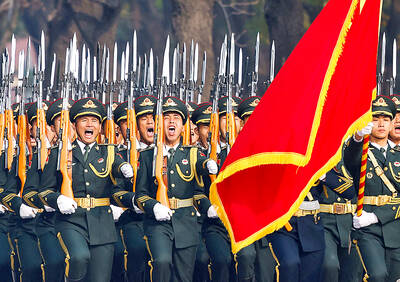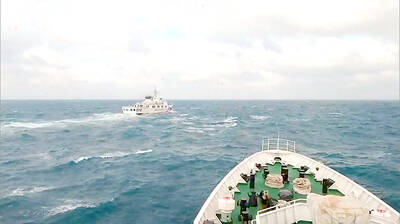The oil rush has come to western Canada, with the US and China jockeying for position in what is potentially the world's biggest source of petroleum, known as the Alberta oil sands.
The potential of the oil sands has been known for decades, but with energy prices soaring and heightened fears of a global supply crunch, a growing number of producers from around the world are stepping up efforts to find ways to explore and extract oil.
The oil sands -- deposits of bitumen, a heavy black viscous oil that needs extensive treatment to be converted into an upgraded crude oil -- contain 175 billion barrels of "proven reserves," the largest in the world outside Saudi Arabia.
For an oil-hungry world, the Alberta sands represents the best opportunity for boosting supplies, some analysts say.
"Can you name me another country in the world that can increase its oil production right now?" asks Greg Stringham, vice president at the Canadian Association of Petroleum Producers.
High Costs
Extracting oil from the sands costs as much as US$12 per barrel, making it more costly than crude from other sources. But industry officials say a market price of more than US$25 a barrel will allow oil from the sands to be profitable.
Canada's total oil production is about 2.5 million barrels per day, of which 80 percent is exported to refineries in the US. Canada supplies about 16 percent of US exports, and 10 percent of all US petroleum.
As producers find new ways to extract and treat the bitumen, Canada could diversify its exports -- and China is among the countries in line.
China's interest in Canada's oil is seen as one of the reasons for the visit of President Hu Jintao (
Industry officials say Canada is likely to boost oil production to about 4 million barrels a day, thus providing an extra 1.5 million barrels to a global economy thirsty for more oil.
Chinese oil firms as well as others, including France's Total SA, are seeking partnerships with their Canadian counterparts as they bid for rights to sands -- found in an area of 140,800km2 of primarily northern Alberta.
Pacific pipeline
PetroChina is in talks with Canada's Enbridge meanwhile on the construction of a pipeline that would transport some 400,000 barrels per day from Fort McMurray, Alberta, to the Pacific coast, for an estimated cost of US$2.5 billion (US$2 billion).
Jiang Wenran (姜聞然), a political scientist at the University of Alberta, said China and Canada have mutual interests in cooperating in the oil sands exploitation. Both however are aware that China's ownership of a strategic asset is a politically sensitivity topic.
"All the major oil companies of China have offices in Calgary but they keep a very low profile," Jiang said. "They are aware of the Canadian debate about strategic and national security implications and they don't want to provoke anything so there are working in a discreet manner."
The US does not want to be left out of the action either. US Treasury Secretary John Snow recently visited the oil sands area, with Vice President Dick Cheney scheduled to follow.
"Now, the world is finally caught on to the fact that yes, these are actually developable," Alberta's Energy Minister Greg Melchin said. "It's a track everybody is interested in, including the United States."
"The United States has clearly begun to see this picture," said Sherry Burns, chief economist at BMO Nesbitt Burns.
"The global geopolitical implications are very important. Canada's role in the global economy and in the political sphere is about to increase dramatically in importance. It's nice to have a world-class bounty that the two largest economic powers desperately need," Burns said.

The Ministry of Foreign Affairs (MOFA) yesterday said it is closely monitoring developments in Venezuela, and would continue to cooperate with democratic allies and work together for regional and global security, stability, and prosperity. The remarks came after the US on Saturday launched a series of airstrikes in Venezuela and kidnapped Venezuelan President Nicolas Maduro, who was later flown to New York along with his wife. The pair face US charges related to drug trafficking and alleged cooperation with gangs designated as terrorist organizations. Maduro has denied the allegations. The ministry said that it is closely monitoring the political and economic situation

Conflict with Taiwan could leave China with “massive economic disruption, catastrophic military losses, significant social unrest, and devastating sanctions,” a US think tank said in a report released on Monday. The German Marshall Fund released a report titled If China Attacks Taiwan: The Consequences for China of “Minor Conflict” and “Major War” Scenarios. The report details the “massive” economic, military, social and international costs to China in the event of a minor conflict or major war with Taiwan, estimating that the Chinese People’s Liberation Army (PLA) could sustain losses of more than half of its active-duty ground forces, including 100,000 troops. Understanding Chinese

UNRELENTING: China attempted cyberattacks on Taiwan’s critical infrastructure 2.63 million times per day last year, up from 1.23 million in 2023, the NSB said China’s cyberarmy has long engaged in cyberattacks against Taiwan’s critical infrastructure, employing diverse and evolving tactics, the National Security Bureau (NSB) said yesterday, adding that cyberattacks on critical energy infrastructure last year increased 10-fold compared with the previous year. The NSB yesterday released a report titled Analysis on China’s Cyber Threats to Taiwan’s Critical Infrastructure in 2025, outlining the number of cyberattacks, major tactics and hacker groups. Taiwan’s national intelligence community identified a large number of cybersecurity incidents last year, the bureau said in a statement. China’s cyberarmy last year launched an average of 2.63 million intrusion attempts per day targeting Taiwan’s critical

‘SLICING METHOD’: In the event of a blockade, the China Coast Guard would intercept Taiwanese ships while its navy would seek to deter foreign intervention China’s military drills around Taiwan this week signaled potential strategies to cut the nation off from energy supplies and foreign military assistance, a US think tank report said. The Chinese People’s Liberation Army (PLA) conducted what it called “Justice Mission 2025” exercises from Monday to Tuesday in five maritime zones and airspace around Taiwan, calling them a warning to “Taiwanese independence” forces. In a report released on Wednesday, the Institute for the Study of War said the exercises effectively simulated blocking shipping routes to major port cities, including Kaohsiung, Keelung and Hualien. Taiwan would be highly vulnerable under such a blockade, because it